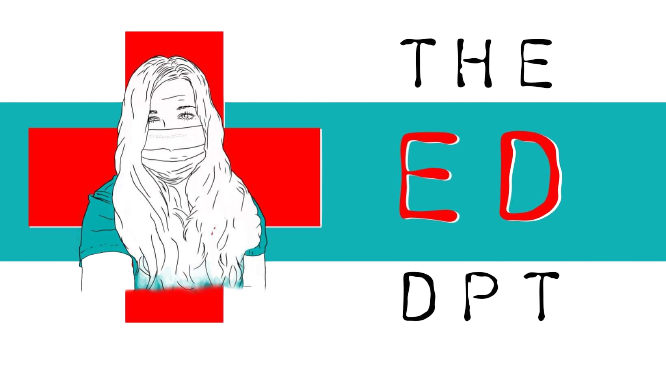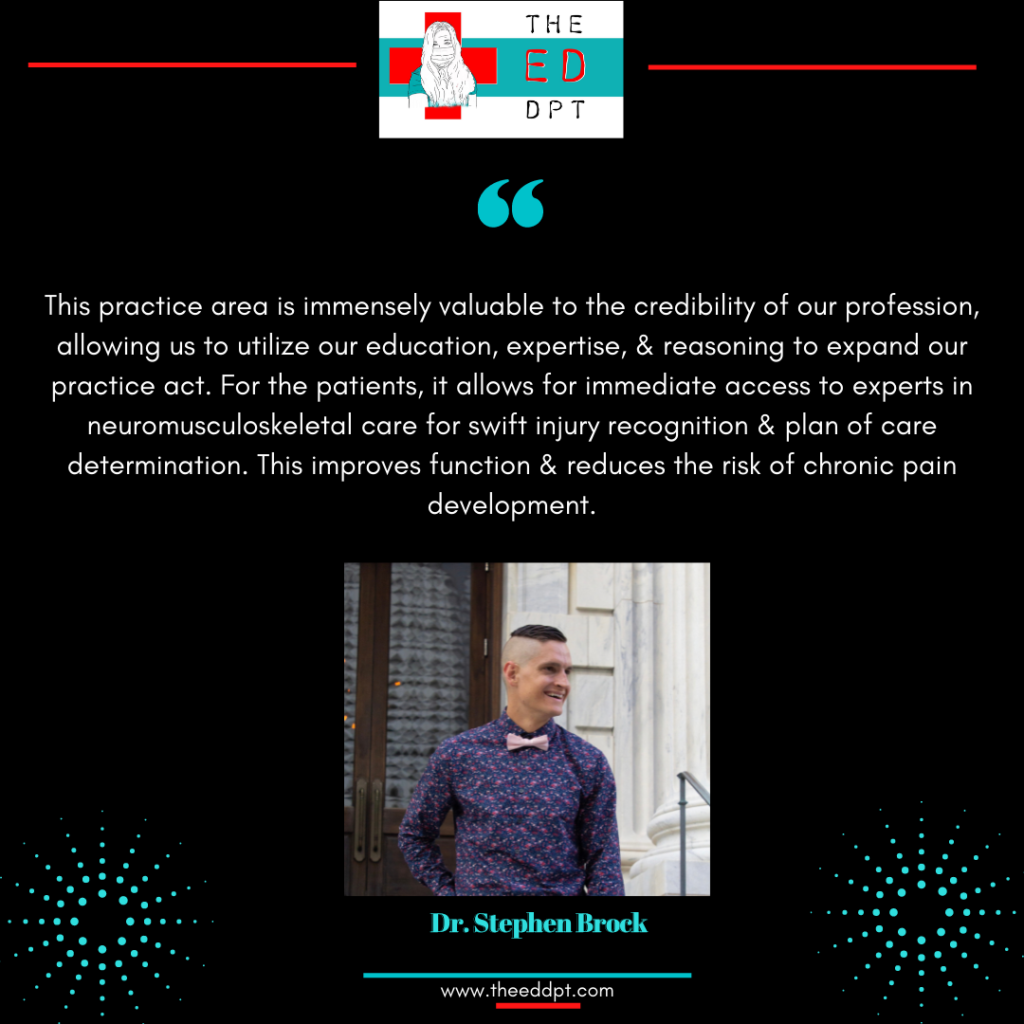Dr. Stephen Brock is a physical therapist practicing in the Veterans Health Administration.

Stephen Brock, PT, DPT, CSCS. Board Certified Clinical Specialist in Orthopedic Physical Therapy. My professional career has mainly involved serving active duty military service members and veterans through the Veterans Health Administration (VHA). I currently reside at the James A. Haley’s Veteran’s Hospital in Tampa (FL), where I am working to improve direct access to rehabilitation services through being embedded in the ER.
How did you become involved in Emergency Department Physical Therapist Practice?
By gracious timing, I was fortunate to have become involved in ED PT practice through my previous detail at the Fayetteville VA Medical Center in Fayetteville, NC. The Chief of Emergency Medicine was very forward thinking, and at the time was working to attain a specific geriatric practice accreditation with the VA system. This involves embedding “special” services within their emergency department, one of them involving PT. Working in an outpatient orthopedics and post-surgical clinic, I was recommended by my supervisor at the time for the role of building the Emergency Department PT clinic.
Describe your practice setting and ED PT model.
I am currently embedded in our ED for two days per week, with the goal of expanding to full time once we achieve adequate staffing within our PT department (previous detail at Fayetteville VA medical center supports full-time embedded PT services). I work with the medical team in the triage, treatment, and placement of neuromusculoskeletal cases, most commonly orthopedic and vestibular/concussion management. I am either consulted on patients or perform self-triage/initial assessments on the patients, whom are always assigned a primary provider/physician to oversee the patient’s episode of care. I perform a primary evaluation/assessment, provide d/c dispositions or plans of care, and if appropriate follow up with patients via telephone or telehealth modes (once coverage is expanded, working to provide live follow up visits if necessary. In my previous setting I was able to schedule patients in outpatient follow up slots if necessary).
Long term goal: advance physical therapy practice to allow VA PTs to practice as licensed independent providers, with the freedom to order appropriate imaging, medication, and consults appropriate to the neuromusculoskeletal presentation.
Why do you think this is a valuable practice area?
This practice area is immensely valuable to the credibility of our profession, allowing us to utilize our education, expertise, and reasoning to expand our practice act. For the patients, it allows for immediate access to experts in neuromusculoskeletal care for swift injury recognition and plan of care determination, which improves function and reduces the risk of chronic pain development.
What was the biggest adjustment for you in practicing in the ED?
I luckily had a smooth transition, as I adapted most of my practice from primary care experience during my residency training. Adjusting from an outpatient mindset of evaluation/plan of care to a more succinct yet direct primary care assessment and treatment lens proved difficult at first. Also, the VA (being lets say a “socialized” form of healthcare) sometimes lends the ED to be a Primary Care dumping ground. This challenges the practitioner to appropriately triage without missing serious or harmful findings on exam.
Do you have an area of specialty?
Orthopedics, Vestibular/Post Concussion, and chronic pain. I would say managing acute on chronic low back pain has been what I have been focusing most of my efforts on in the VA, being the leading diagnosis that presents to VA EDs.
What barriers did you have to overcome personally and within your facility to practice successfully in this environment?
Confrontation with other providers has been something that I normally shy away from. Luckily within my department, most of the providers are EXTREMELY receptive to PT services. Currently our largest challenge is staffing of ED PT’s, which subsequently leads to declining “on-call” requests from ED providers. Hospital leadership have expressed desire and plan to expand coverage to a full time embedded PT in the ED, however we all adhere to the government’s model: HURRY UP AND WAIT.
What is your philosophy about what makes an ideal ED PT?
One must be adaptable, flexible, bold, and efficient in their encounters with patients and providers alike. Particularly in the veteran population, a little warmth and choice words go a long way to quickly build a therapeutic alliance.
What was your biggest win in the ED?
The ANNIE APP for low back pain. A clinical team and I developed a program disseminated through a text-based self help app that guides veterans through self managing their low back pain following their episode of care in the emergency department.
This includes a 2 week protocol including education, self reported outcome measure tracking (NPRS and PSFS/GRC scale), reminders for general and specific movement prescription, and graded walking plan progression
It is national initiative within the VA- eventual expansion to other diagnoses.
To Learn More From Dr. Brock
Listen to our podcast or watch the full video interview.


